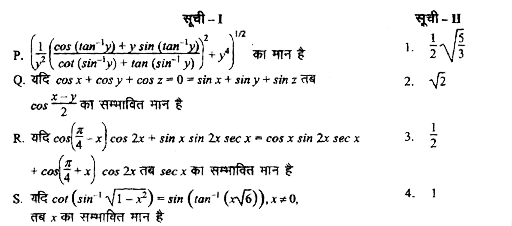Let f(x)=(1−x)2sin2x+x2 for all x∈IR and let g(x)=x∫1(2(t−1)t+1−lnt)f(t) dt for all x∈(1,∞).
Which of the following is true ?
(1,∞) में g वर्धमान (increasing) है
(1,∞) में g ह्रासमान (decreasing) है
(1, 2) में g वर्धमान है और (2,∞) में ह्रासमान है
(1, 2) में 8 ह्रासमान है और (2,∞) में वर्धमान है
Step by step video & image solution for Let f(x) = (1-x)^(2) sin^(2)x+ x^(2) for all x in IR and let g(x) = underset(1)overset(x)int((2(t-1))/(t+1)-lnt) f(t) dt for all x in (1,oo). Which of the following is true ? by Maths experts to help you in doubts & scoring excellent marks in Class 12 exams.
Updated on:21/07/2023Topper's Solved these Questions
- JEE ADVANCED पेपर - 2 (2012)BOOK - JEE Main & Advanced (Hindi Medium)CHAPTER - JEE ADVANCED पेपर - 2 (2012)EXERCISE - भाग - III : गणित खंड - III : बहुल सही उत्तर प्रकार
6 Videos
- JEE ADVANCED पेपर - 2 (2012)BOOK - JEE Main & Advanced (Hindi Medium)CHAPTER - JEE ADVANCED पेपर - 2 (2012)EXERCISE - भाग - III : गणित खंड - III : बहुल सही उत्तर प्रकार
6 Videos
- JEE ADVANCED पेपर - 1 (2021)BOOK - JEE Main & Advanced (Hindi Medium)CHAPTER - JEE ADVANCED पेपर - 1 (2021)EXERCISE - MATHEMATICS (खंड- 3)
9 Videos
- JEE ADVANCED पेपर - 2 (2013)BOOK - JEE Main & Advanced (Hindi Medium)CHAPTER - JEE ADVANCED पेपर - 2 (2013)EXERCISE - PART III : MATHEMATICS (खण्ड - 3) (सुमेलन सूची प्रकार)
4 Videos
Similar Questions
दो घटनायें X और Y इस प्रकार की हैं कि P(X∣Y)=12,P(Y∣X)=13 और P(XnY)=16 तब निम्न में से कौन कथन सही है/हैं?
View Solutionदो घटनायें X और Y इस प्रकार की हैं कि P(X∣Y)=12,P(Y∣X)=13 और P(XnY)=16 तब निम्न में से कौन कथन सही है/हैं?
View Solutionकिसी 3×3 आव्यूह M के लिए, माना |M| ,M के सारणिक को निरूपित करता है। माना
E=⎡⎢⎣12323481318⎤⎥⎦,P=⎡⎢⎣100001010⎤⎥⎦ तथा F=⎡⎢⎣13281813243⎤⎥⎦
यदि Q कोटि 3×3 का एक व्युत्क्रमणीय आव्यूह है, तब निम्न में से कौनसा/कौनसे कथन सही है/हैं?
View Solutionसूची I को सूची II से सुमेलित कीजिए तथा सूचियों के नीचे दिए गए कोड का प्रयोग करके सही उत्तर चुनिये :

View SolutionLet F(x)=f(x)+f(1x),w h e r ef(x)=∫xtlogt1+tdt. (1) 12 (2) 0 (3) 1 (4) 2
View SolutionLet f:[1,∞] be a differentiable function such that f(1)=2. If 6∫x1f(t)dt=3xf(x)−x3 for all x≥1, then the value of f(2) is
View SolutionLet f(x)=(1−x)2sin2x+x2 for all x∈IR, and let g(x)=∫x1(2(t−1)t−1−lnt)f(t) dt for all x,∈(1,∞). Consider the statements: P: There exists some x∈IR such that f(x)+2x=2(1+x2) Q: There exists some x∈IR such that 2f(x)+1=2x(1+x) Then
View SolutionLet f(x)=(1−x)2sin2x+x2 for all x∈IR, and let g(x)=∫x1(2(t−1)t−1−lnt)f(t) dt for all x,∈(1,∞). Which of the following is true?
View SolutionConsider the function f:(−∞,∞)→(−∞,∞) defined by f(x)=x2−ax+1x2+ax+1;0<a<2. Let g(x)=∫ex0f'(t)1+t2 dt. Which of the following is true?
View SolutionLet f(x)=∫x3x2dtlnt for x>1andg(x)=∫x1(2t2−lnt)f(t)dt(x>1), then:
View SolutionFor any x∈R,andfbe a continuous function Let I1=∫1−cos2xsin2xtft(2−t)dt,I2=∫1+cos2xsin2xf(t(2−t))dt, then I1=
View SolutionLet f(x)=1(1−x)2sin2x+x2 for all x∈IR, and let g(x)=x∫1(2(t−1)t+1−lnt)f(t)dt for all x∈(1,∞)
Which of the folloiwng is true ?
View SolutionLet f(x)=(1−x)2sin2x+x2 for all x∈R, and let g(x)=∫x1(2(t−1)t+1−logt)f(t)dt for all x∈(1,∞).
Consider the statements :
P : there exists some x∈R such that
f(x)+2x=2(1+x2)
Q : There exists some x∈R such that
2f(x)+1=2x(1+x) then-
View SolutionLet f(x)=(1−x)2sin2x+x2 for all x∈R, and let g(x)=∫x1(2(t−1)t+1−logt)f(t)dt for all x∈(1,∞).
Which of the following is true?
View SolutionLet f(x)=(1−x)2sin2x+x2 for all x∈R, and let g(x)=∫x1(2(t−1)t+1−logt)f(t)dt for all x∈(1,∞).
The number of real roots of the equation f(x)=1 in the interval [0, 1] is -
View SolutionConsider the function f : (−∞,∞)→(−∞,∞) defined by f(x) = x2−ax+1x2+ax+1,0<a<2
Let g(x)=ex∫0f'(t)1+t2dt
Which of the following is true ?
View Solution
